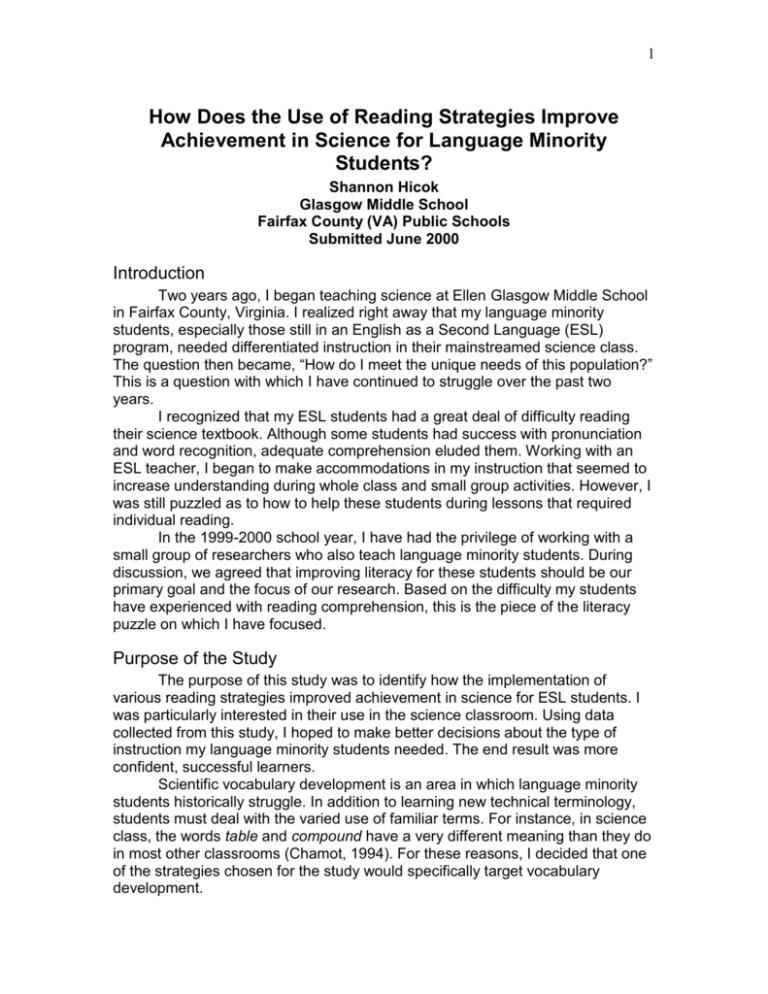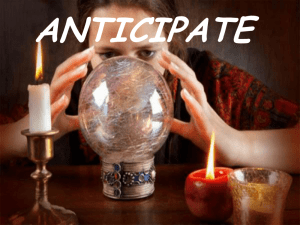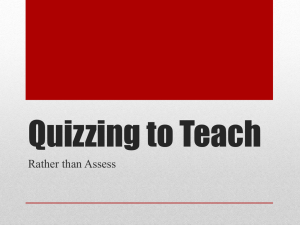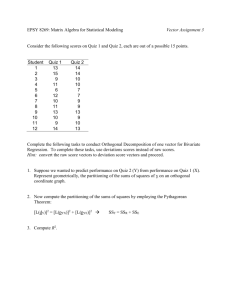How Does The Use Of Reading Strategies Improve Achievement In
advertisement

1 How Does the Use of Reading Strategies Improve Achievement in Science for Language Minority Students? Shannon Hicok Glasgow Middle School Fairfax County (VA) Public Schools Submitted June 2000 Introduction Two years ago, I began teaching science at Ellen Glasgow Middle School in Fairfax County, Virginia. I realized right away that my language minority students, especially those still in an English as a Second Language (ESL) program, needed differentiated instruction in their mainstreamed science class. The question then became, “How do I meet the unique needs of this population?” This is a question with which I have continued to struggle over the past two years. I recognized that my ESL students had a great deal of difficulty reading their science textbook. Although some students had success with pronunciation and word recognition, adequate comprehension eluded them. Working with an ESL teacher, I began to make accommodations in my instruction that seemed to increase understanding during whole class and small group activities. However, I was still puzzled as to how to help these students during lessons that required individual reading. In the 1999-2000 school year, I have had the privilege of working with a small group of researchers who also teach language minority students. During discussion, we agreed that improving literacy for these students should be our primary goal and the focus of our research. Based on the difficulty my students have experienced with reading comprehension, this is the piece of the literacy puzzle on which I have focused. Purpose of the Study The purpose of this study was to identify how the implementation of various reading strategies improved achievement in science for ESL students. I was particularly interested in their use in the science classroom. Using data collected from this study, I hoped to make better decisions about the type of instruction my language minority students needed. The end result was more confident, successful learners. Scientific vocabulary development is an area in which language minority students historically struggle. In addition to learning new technical terminology, students must deal with the varied use of familiar terms. For instance, in science class, the words table and compound have a very different meaning than they do in most other classrooms (Chamot, 1994). For these reasons, I decided that one of the strategies chosen for the study would specifically target vocabulary development. 2 The remainder of the strategies chosen for the study were intended to help make reading a more active endeavor. I chose these strategies with the hopes that they would help students comprehend written, scientific, factual material. Literature Review Much research has been done regarding the effectiveness of using learning strategies to promote literacy. The basic premise behind this research is that students can benefit from the implementation of activities that help them understand and construct meaning from text. The results of this extensive research have shown that better reading comprehension leads to increased achievement. Margaret Hill states, “Perhaps our first campaign must be the promotion of literacy. We must convince our youth of the importance of literacy, and then it must become a necessary goal for their own survival.” Hill contends that struggling adolescent readers need an increased level of involvement with written material in order to construct meaning. This involvement can be achieved with a variety of strategies that tap into student areas of interest, such as speaking or drawing. Students should also have the opportunity to interact with one another while processing written information. Hill outlines several instances in which the use of strategies has increased student confidence and achievement (Beers, 1998). Joseph Vaughan and Thomas Estes agree that all students benefit from the direct instruction of learning strategies. In Reading and Reasoning Beyond the Primary Grades, Vaughan and Estes break reading lessons down into three phases: anticipation, realization, and contemplation. Anticipation activities should introduce the topic of the selected passage and access student’s prior knowledge. Realization activities make the reader focus on the meaning of the passage as a whole. Contemplation activities aid in the processing of information after the passage has been read. Robertta Barba’s research pertains specifically to culturally diverse science classrooms. She feels that, especially in this setting, reading must be an active endeavor. She advocates the use of reading guides and post-reading activities to help students comprehend and summarize the most important concepts in a text (Barba, 1998). This same view is evident in the Cognitive Academic Language Learning Approach, (CALLA), developed for ESL learners. This instructional approach is based on the idea that “active learners are better learners.” Strategies ranging from metacognitive to social are used across the curriculum to help ESL students acquire and understand new content vocabulary and concepts, (Chamot, 1994). Certain aspects are common to all of the studied research. The research clearly shows that reading should be treated as an active process. Readers should be aided in their quest to derive meaning from text. Adequate processing time, carefully selected reading and questioning strategies, and cooperative grouping are essential components in this process. When reading and learning 3 strategies are properly implemented, this research indicates a positive impact on student self-confidence, reading ability, and overall achievement. Data Collection and Observations This study examines 22 seventh grade ESL B2 students in three different Life Science classes. These students were reading on the fifth or sixth grade level. The study spanned two seventh grade content units: Genetics and Ecology. The chosen reading strategies were intended to do the following things: 1) assist students in the development of scientific vocabulary, 2) access student’s knowledge prior to reading a passage in their text, 3) help students pick out essential information while reading, and 4) process and remember important concepts after reading. The data collected was primarily qualitative. My own notes, answers to student questionnaires, and an analysis of quiz and test scores served as the basis for my conclusions. Before beginning the study in earnest, I decided to administer the CLOZE reading test, a test designed to measure the readability of the science textbook (Vaughan, 1986). As I predicted they would, the results showed the text to be on the frustration level of the readers. The group’s ability to interpret context clues and recognize vocabulary within the text was low, and therefore their overall understanding of the information it contained was minimal. Several reading strategies were implemented over the course of the fourmonth study. For vocabulary development, students constructed graphic organizers in the form of vocabulary books. To help students access and build knowledge prior to reading, anticipation guides and concept maps/webs were implemented. Anticipation guides were also used during reading and were intended to help students pick out essential ideas. Students processed information after reading by using a variety of strategies such as graphic organizers, fill-in-the-blank activities, and informational webs. Vocabulary Books. These books were intended to help students interpret the meaning of scientific vocabulary. The books themselves were made with copy and construction paper. Each book contained enough space for fourteen words. Three surfaces were used for each term. Each surface contained various information about the term. On one surface, the word itself was written. The definition and a drawing that depicted the meaning of the term were on the other two surfaces respectively. These books were constructed at the beginning of each content unit and terms were added in the order in which they were studied (Figure 1). 4 Figure 1 When I initially implemented vocabulary books, students struggled with the process. Copying the definition of each word was easy, but drawing a picture proved to be quite the opposite. My notes and observations led to the belief that as students struggled, their understanding of each term deepened. Students were able to visually represent information with greater ease by the end of the first unit of study. Also, it is evident from my observations that the students began to enjoy the activity more as they became accustomed to the process. When students were asked if vocabulary books had helped them learn, all of the students in the test group responded positively. When asked if vocabulary books were useful when studying for quizzes, 17 students said, “Yes” and the remaining five responded, “Sometimes.” When asked if they liked vocabulary books, 14 students said, “Yes,” four said, “Sort of,” and four said, “No.” The following 5 comments were written by various students in the test group regarding vocabulary books: “The vocabulary book helps me because I try to draw pictures that I would remember and that mean something, so I can remember back to the pictures.” “The vocabulary book helps me because it shows what the word means, but it’s hard work to do one.” “It helped me learn because it has pictures and that makes me remember the word better so that I can do better on quizzes and tests.” “ ...sometimes it’s hard to draw the picture or write the definition of some words, but it helps me learn as I draw pictures.” “The pictures help bring my memory back when I forget.” “I like the way the book is organized.” “It’s easier for me to study using the vocabulary book.” All of the comments were extremely positive. Although a few students commented on the hard work that goes into making a vocabulary book, all of the students felt that the books helped them in some way. Anticipation Guides, Concept Maps/Webs. Anticipation guides were intended to make students more active readers by: 1) introducing the topic of the passage and accessing each student’s prior knowledge, 2) helping students focus on the pertinent points in the reading by giving them specific things to look for, and 3) giving students a study guide to use after reading was complete. Before reading, students were asked to respond to a series of statements about the topic by identifying each as true or false. They then discussed their answers as a class or in small cooperative groups. Their job as they read the passage independently was to correct all the incorrect answers on the anticipation guide. (Figure 2) 6 Figure 2 Anticipation Guide - DNA is Here to Stay Directions: Before reading pages 3 - 15 in the book DNA is Here to Stay, read the statements below. Decide whether each statement is true or false and write your answer in the blank beside the statement. As you read, correct each wrong answer and rewrite the incorrect statements so that they are true. _____1) Every cell carries a complicated “plan” for making an organism. _____2) The plan for making an organism is on it’s deoxyribo-nucleic acid (DNA for short.) _____3) DNA is located in the chromosomes, which are in a cell’s mitochondria. _____4) Every human cell has exactly 38 chromosomes. _____5) DNA strands are easy to see with a microscope. _____6) When a cell is about to divide, it’s DNA coils up tightly and that is why we can see the chromosomes at that time. _____7) DNA looks like a twisted ladder. We refer to this structure as a single helix. 7 Concept maps were used in different ways depending on the purpose of the activity. One way these maps were used was as an introduction to a topic. This activity began with one word written on the overhead projector. Volunteers were asked to share all their knowledge about that topic with the class. As students generated information, the teacher added it to the concept map on the overhead. Concept maps were also used after reading as a processing activity. Students were asked to fill in the missing information on a teacher generated concept map that contained the most important points from the passage. (Figure 3) Figure 3: All Organisms ____________ __________ cannot make their own food can make their own food __________ eat plants ___________ eat plants and animals detritivores eat plants and other producers go through the process of ______________ _________ carnivores eat _________ 8 When anticipation guides and concept maps were incorporated into a reading assignment, the level of student interest and involvement increased. Students in the test group were observed sub-vocalizing as they read to one another quietly. These behaviors, which often indicate focused reading, had not been observed during previous reading assignments. Also, students stopped often during reading to make corrections to their anticipation guides, indicating the processing of important information. Constructing concept maps before reading increased the amount of student excitement regarding the topic of the selected passage. Students seemed to thoroughly enjoy discussing the given topic. This was noted when many students in the class began eagerly yelling out terms and phrases to be added to the class web. In addition, when these strategies were used, students were able to retain important information for extended periods of time. For example, after constructing a concept map on camouflage, many students referenced the information from the web on written assignments over the course of several weeks. The following comments were made by students in the test group regarding anticipation guides: “ Anticipation guides help me not to get confused. ” “ Anticipation guides help me a lot because I can remember the things that they say.” “ Anticipation guides help me because they make me read slower and more carefully to figure out if a statement is right or if I will have to fix it.” “ Anticipation guides help me remember what I’ve read because you really have to focus on what you are reading.” Despite some success, a few students continued to flip through the text looking for key words without truly reading. This was a source of frustration for me throughout the study. Fill-in-the-blank review guides. These guides were intended to help students pick out and remember main ideas and important supporting details after reading. The teacher- generated paragraphs reviewed key concepts presented in the text. Several key words were deleted from the document and students were responsible for filling them in. This activity was done individually with the hopes of generating greater student-text interaction (Figure 4). 9 Figure 4 Name - ______________________ Date - ______________ Block - ___________ ECOSYSTEM CONCEPT REVIEW Directions: Fill in the blanks below with the appropriate word or words. You may use your notes, book and lab book to help you. _____________________ factors are the living organisms in the biosphere, whereas ____________________ factors are not living. Elodea, snails, and duckweed are examples of _________________ factors in your aquarium. Water quality and temperature are examples of ____________________ factors in your aquarium. Organisms of the same species living together make up a _________________. When a variety of species are found living together, they make up a ___________________. ___________________ are comprised of communities and the abiotic factors that affect those communities. In our class fish tank, all of the neon tetras would be an example of a ___________________. All of the fish in the tank make up a _____________________. All of the living and non-living things in our fish tank make up an ________________________. __________________________ are organisms that can make their own food. __________________________ cannot make their own food and must eat other organisms for energy. In your aquarium, duckweed, elodea, and algae are examples of ________________________ because they carry on the process of ____________________. This process takes place in the ___________________ of each cell. It is through this process that water, _____________ _______________, and __________________ energy are used to make sugar and ____________________. The oxygen is given off and the sugar is broken down in the process of ______________________. During ____________________, food is broken down and ___________________ is released. Oxygen must be present in order for this to occur. 10 When this strategy was initially implemented, I expected students to hate it. I was pleasantly surprised when quite the opposite occurred. Students worked diligently to fill in all of the blanks on the activity. The room became completely silent as students flipped through their notes and textbooks looking for the answers. Students were forced to use context clues in order to figure out the correct answers. When this sort of activity was given immediately prior to a quiz, quiz scores among the test population were quite good. Written responses from students regarding this strategy were extremely positive. When asked which of the studied strategies helped them the most, a majority of the students in the test group described this strategy as their “favorite.” Below are several examples of student comments: “ I really like the fill in the blank activity. I think of it as a contest and there will be a big prize if I can answer all of them. I try to go back and check the answers, so that lets me know what I still need to learn and what I already know.” “ I like the fill in the blank review best because we got to use our notes and review them. I also liked it because it helps the answers stay in my mind.” “ I liked the fill in the blank review because we got to look at our notes and by reading my notes I learn more.” “ For me, the fill in the blank review is the most helpful because all of the blanks match up with important words in the chapter. This activity makes me read to find the answer.” “ Fill in the blank helps because we have to go through our labs, so not only do we get the answers, we also remember some of the old stuff.” “ Fill in the blank is good because it made me reread my notes, labs and science textbook.” “ With the help of the sentences on the fill in the blank review, I remembered the facts.” “ The fill in the blank review helps me rethink about it and remember it.” “ Fill in the blank review keeps me very focused because somehow, in a way, it knocks the memory that I forgot back into me. It is also useful for studying for tests.” “ The fill in the blank review helps me remember what I study. It’s like a reminder to me.” 11 In addition to my own notes and student input regarding the strategies in the study, I also looked at student quiz and test scores. When I began the study, I hypothesized that quiz and test scores would show improvement. After constructing individual student graphs however, I found that no pattern emerged among quiz and test scores. Although some student’s scores improved, others declined and some showed no change at all. This was the most disappointing and baffling finding in the study. It is my belief, given the positive qualitative findings, that a longer study would yield more positive quantitative results. Findings In order to appropriately report findings, one must return to the study’s original purpose. The purpose of this study was to determine how the use of reading strategies improves achievement in science for language minority students. Looking at quiz and test scores, one could argue that achievement did not improve. Achievement, however, is not only defined by numbers and grades. An increase in one’s ability to derive meaning from text is an achievement. The ability to pick out and remember the main ideas in a written passage is an achievement. The development and use of scientific vocabulary is an achievement. Although the study was disappointing in the respect of quiz and test scores, some positive conclusions could be drawn. The most significant findings as to how these strategies affect student achievement are as follows: The use of these particular strategies increased the amount of student focus during reading and aided in the processing of pertinent information. Students were better able to pick out and remember important facts within the text when reading strategies were used. The reading/vocabulary strategies themselves became useful tools when studying for quizzes and tests. Implications for Further Study This research study raised many questions that warrant further investigation. The fact that quiz and test scores did not shown a pattern of improvement despite positive qualitative results was puzzling. As stated before, it is my belief that the brief length of the study was a major contributing factor. Designing a similar study with a much longer period of data collection would be a worthwhile undertaking. Another possible outgrowth of this research is a comparison of the effectiveness of each type of reading strategy. Which strategy seems to work the best and why? The study could be expanded to include several additional strategies in order to better accommodate all learning styles. 12 References Barba, R.. (1998). Science in the Multicultural Classroom, A Guide to Teaching and Learning. Boston: Allyn & Bacon. Beers, K. & Samuels, B. (1998). Into Focus: Understanding and Creating Middle School Readers. Noorwood: Christopher-Gordon. Chamot, A. & O’Malley, J.M. (1994). The CALLA Handbook, Implementing the Cognitive Academic Language Learning Approach. Reading: AddisonWesley, Vaughan, Joseph. and Estes, Thomas. (1986). Reading and Reasoning Beyond the Primary Grades. Boston: Allyn and Bacon, Inc.





